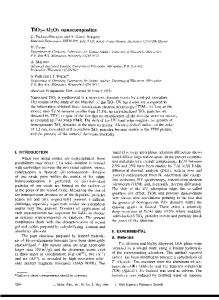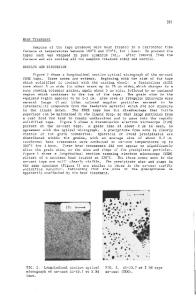Rapid Solidification of an Al 2 O 3 -25WT.PCT.ZrO 2 Oxide Alloy
- PDF / 1,448,613 Bytes
- 4 Pages / 417.6 x 639 pts Page_size
- 8 Downloads / 267 Views
RAPID SOLIDIFICATION OF AN Al 2 03 -25WT.PCT.ZrO 2 OXIDE ALLOY TEIICHI ANDO*, YUH SHIOHARA** and M.C. FLEMINGS*** * Toyo Kohan Co. Ltd., Visiting scientist, Materials Processing Center, ** Materials Processing Center, Massachusetts Institute of Technology, * Dept. of Materials Science and Engineering, Massachusetts Institute of Technology, Cambridge, MA 02139 ABSTRACT TEM observation of the morphology of alumina dendrites in a rapidly solidified Al O-25w/oZrO2 oxide alloy revealed three distinct dendrite morphologies c4r~esponding to a-, Y- and 6- aluminas. STEM analysis showed the center of the c and Y dendrites to be solute poor, but the 6 dendrite center to be solute rich, indicating possible solute trapping. Theoretical calculations show interface growth velocities in excess of 3m/sec. INTRODUCTION The A O3 -ZrO 2 psuedobinary phase diagram shows only a limited solubility 3f ZrO2 in a-Al 2 O[1]. Relatively few data have been reported on the solubility extension bt rapid solidification(RS) of oxide alloys[2]. Among them, the MgAl 0 4 (spinel) phase in the Al 0-ZrO2 system has been reported to exist in Compositions extending to pure alumina[2]. Polymorphism has been reported to exist in RS pure alumina[3]. The reported non-equilibrium modifications, Y-(cubic) and 6 -(tetragonal) aluminas have a spinel structure with varying degrees of lattice disorder[4]. Such polymorphism may be directly linked with the formation of non-equilibrium phases with high solute solubilities in the solidification of a highly undercooled liquid oxide alloy. The purpose of this investigation was to examine the interrelationship between solidification conditions and phase formation in a rapidly solidified A1l03 -25 w/o ZrO oxide alloy. Of particular interest was to examine possi le metastable itructures. EXPERIMENTAL Rapidly solidified(RS) samples of an Al 0-25 w/o Zr,2 alloy were produced by melt extraction. Sintered pel~e s 12mm in •iameter were prepared from fine grain reagent grade powders of Al2 01 and ZrO2 . The top surface of the pellets was melted in air with an oxidizing oxy-acetylene flame and a copper extraction wheel was pressed against the liquid ceramics which produced thin (50-150Pm) flakes of RS Al2 0 3 -ZrO, alloy samples. The RS flakes were ion-milled for examination by &'ansmission electron microscopy (TEM) and scanning transmission electron microscopy (STEM).
RESULTS AND DISCUSSION The overall microstructure of the RS oxide alloy appears dendritic. Furthermore, the dendrites were found to have three distinct morphologies as shown in Fig.l. The coarsest dendrites in Fig.l(a) show the expected hexagonal symmetry of cc-Al20 3 , whereas the finer dendrites with well developed secondary and tert1ary arms, Fig.l(a), indicate an orthogonal symmetry. The third, and the finest morphology shown in Fig.l(b) also has an orthogonal symmetry although no tertiary arms are clearly observed. The
Mat. Res. Soc. Symp. Proc. Vol. 58. 1986 Materials Research Society
456
Fig.1
Annular dark field images A12 03 -25wt.pct.ZrO2 alloy. 'TR
Data Loading...











